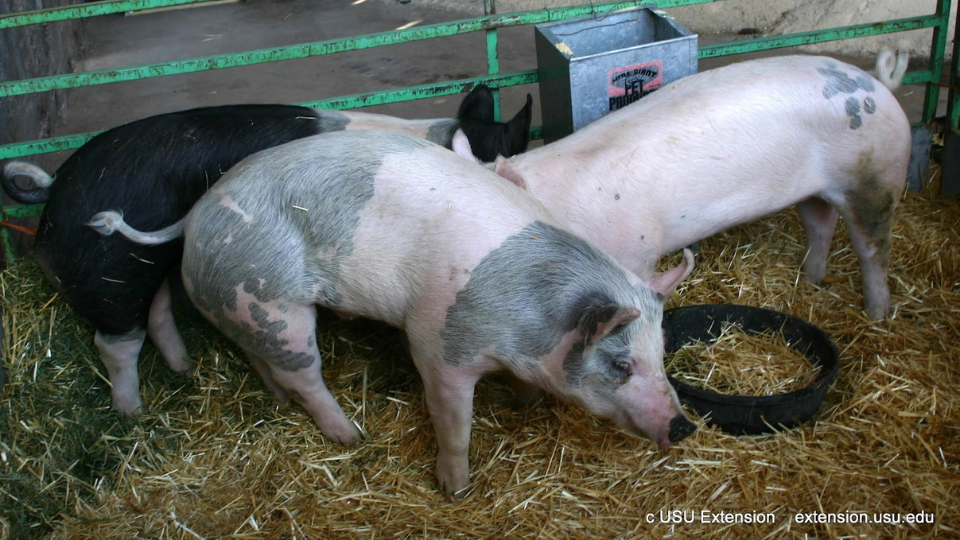Livestock Risk Protection Insurance: Swine

What are the specifics about swine insurance?
Livestock Risk Protection (LRP) specific coverage endorsements (SCE) can be purchased for swine up to an annual limit per producer of 750,000 hogs, with a maximum of 70,000 hogs per SCE. While that is the maximum per contract, producers can purchase LRP insurance contracts for as little as one head. Producers can purchase insurance for both born and unborn swine. Contracts for swine that are born before the start of the policy range from 13, 17, 21, 26, and 30 weeks, while contracts for swine born after the effective date of the policy range from 30, 34, 39, 42, 47, and 52 weeks (Risk Management Agency [RMA], 2022). Find general information about how the LRP insurance program works in the companion Utah State University Extension fact sheet titled “Livestock Risk Protection Insurance FAQ.”
What are the "optimal" coverage options?
LRP contracts that return an indemnity to a producer greater than the subsidized premium cost could be defined as having a positive net return. Those combinations of coverage length and level that have historically provided the highest probability of a positive net return while also providing the highest average net return could be defined as “optimal” contracts (Haviland & Feuz, 2022). Table 1 summarizes these optimal contracts for each marketing month (the month in which a producer intends to market livestock). LRP coverage lengths of 13, 17, 21, 26, and 30 weeks are shown, with coverage levels of 85%–100% split into 5 groups:
- 1 = (85.00% - 89.99%).
- 2 = (90.00% - 92.49%).
- 3 = (92.50% - 94.99%).
- 4 = (95.00% - 97.49%).
- 5 = (97.50% - 100.00%).
The optimal contracts, already defined, are those cells within Table 1 shaded in gray and marked with an “X.”
An online tool, Livestock Risk Protection (LRP) Support Tool (https://farmanalysis.usu.edu/lrp/), is available to help producers visualize which contracts are optimal based on their marketing month and specific commodity. The optimal contracts identified within Table 1 may not correspond directly to those identified using the LRP online decision tool. This discrepancy can arise as the online tool is continuously updated as new LRP data becomes available.
|
Table 1. LRP Swine “Optimal” Combinations of Coverage Length and Level by Marketing Month |
||||||||||||
|
Coverage length/levela |
Jan. |
Feb. |
Mar. |
Apr. |
May |
Jun. |
Jul. |
Aug. |
Sep. |
Oct. |
Nov. |
Dec. |
|
13/1 |
||||||||||||
|
13/2 |
X |
|||||||||||
|
13/3 |
X |
|||||||||||
|
13/4 |
X |
X |
X |
X |
||||||||
|
13/5 |
X |
X |
X |
X |
X |
X |
X |
X |
||||
|
17/1 |
||||||||||||
|
17/2 |
X |
|||||||||||
|
17/3 |
X |
|||||||||||
|
17/4 |
X |
X |
X |
X |
||||||||
|
17/5 |
X |
X |
X |
X |
X |
X |
X |
X |
||||
|
21/1 |
||||||||||||
|
21/2 |
||||||||||||
|
21/3 |
X |
|||||||||||
|
21/4 |
X |
X |
X |
X |
X |
X |
||||||
|
21/5 |
X |
X |
X |
X |
X |
X |
X |
X |
X |
X |
||
|
26/1 |
||||||||||||
|
26/2 |
X |
|||||||||||
|
26/3 |
X |
X |
X |
X |
||||||||
|
26/4 |
X |
X |
X |
X |
X |
X |
X |
|||||
|
26/5 |
X |
X |
X |
X |
X |
X |
X |
X |
X |
X |
||
|
Notes. Optimal combinations of coverage length and level are those that have historically provided the highest average net return and highest probability of a positive net return. The optimal combinations are shaded in gray and marked with an “X.” a Coverage length/levels are defined as the length in weeks and the levels coded as 1 = (85.00%–89.99%), |
||||||||||||
How were the optimal contracts determined?
The optimal contracts are based on historical performance of LRP contracts from 2005–January 2023. The net return and probability of positive net return were analyzed for each combination of coverage length and level, and those combinations that were statistically the highest (5% significance level) were taken as the optimal set.
What patterns exist within the optimal contracts?
Patterns within the optimal contracts identified for swine suggest that generally higher coverage levels have historically been more likely to return a positive net return as well as the highest average net return across all marketing months. No marketing month has an optimal contract identified at a coverage level below 90%, with the majority above 95%. No pattern within coverage length is identified as optimal contacts are identified within every coverage length category for all marketing months. This suggests that producers purchasing swine LRP insurance should prioritize purchasing contracts with relatively higher coverage levels to help mitigate price risk.
Example
As an example of how the information in Table 1 could be used, assume a producer seeks to mitigate price risk for swine to be marketed in January. Referencing Table 1, this producer seeking to purchase a historically optimal contract could purchase a contract for 13, 17, or 26 weeks in October, September, or July, respectively, with a coverage level of 5 (95%–100%). Of course, having been identified as historically optimal does not guarantee similar future performance. However, as producers make LRP coverage selections, this historically optimal set can provide some objective ranking information based on historical performance to guide producers in their selection process.
Sources
- Haviland, L. B., & Feuz, R. (2022). Livestock risk protection: Selecting optimal coverage contracts for producers. In Western Economics Forum (Vol. 20, No. 2, pp. 63–74).
- Risk Management Agency (RMA). (2022). Livestock risk protection policy specific coverage endorsement - swine.U.S. Department of Agriculture. https://www.rma.usda.gov/-/media/RMA/Policies/Livestock-Risk-Protection-Swine/2023/LRP-Swine-Endorsement.ashx?la=en
February 2024
Utah State University Extension
Peer - Reviewed Fact Sheet
Authors
Logan Haviland and Ryan Feuz
Related Research














